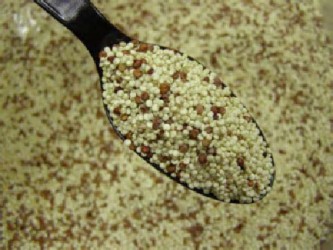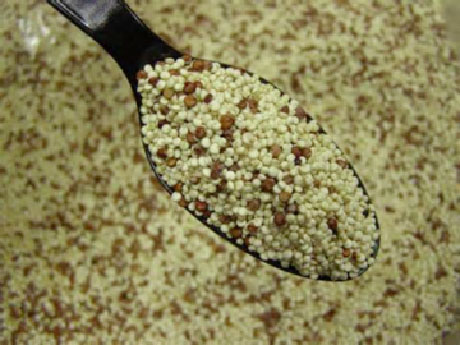SYDNEY, (Reuters) – Australia and the United States, two of the world’s biggest wheat exporters, are racing to become mass producers of the South American “super food” quinoa and tap a gluten-free market expected to be worth more than $6 billion by 2018. Importantly for Australian wheat farmers who regularly battle crop-destroying droughts, the nutritious grain-like seed pronounced ‘kin wa’ can handle extreme climates.
It also sells for around $3,000 a tonne, compared with wheat which fetches under $300 a tonne.

It also sells for around $3,000 a tonne, compared with wheat which fetches under $300 a tonne.
“We have been growing quinoa for about five years now, and as the market has grown, there is little shortage of other farmers willing to turn to quinoa,” said Ashley Wiese, a farmer in Narrogin, southeast of Perth in Western Australia state.
Quinoa, the staple of Andean farmers for thousands of years, has taken health-conscious Western nations by storm.
Demand grew 300 percent between 2007 and 2012, data from the U.N. Food and Agriculture Organization shows, as traditional suppliers Bolivia, Peru, Chile and Ecuador struggle to meet demand from health-conscious Western consumers.
Quinoa prices doubled from 2007 to 2009 and rose almost unchecked until a peak in 2014, according to U.N. data. Demand for the nut-flavoured quinoa shows little sign of easing. The size of the global gluten free market is forecast to grow at 10 percent a year to be worth more than $6.2 billion by 2018, according to a 2013 report by Research and Markets.
Quinoa’s attraction is that it is high in protein, gluten free, and is the only food crop that contains all the essential amino acids, trace elements and vitamins.
RIGHT SEEDS KEY TO
MASS PRODUCTION
Developing the right seeds and farming techniques to mass produce quinoa, which is traditionally grown on small acre farms in the Andes mountains, is the key to entering a market where global demand is outstripping traditional supply.
Australian scientists say they are less than three years away from developing a quinoa for the nation’s hot, dry climate.
“Without appropriate yields, it is not commercially viable, but it has to have good quality that markets expect as well, so selection for a variety takes time,” said Dr John de Majnik, senior program manager at Rural Industries Research & Development Corporation.
U.S. farmers have been producing quinoa since the 1980s, but mass production still eludes them.
White Mountain Farm in the southern Colorado Rocky Mountains is one of the biggest producers, taking advantage of the high altitude which is the traditional quinoa climate. “I estimate we are four to five years away from developing varieties adapted to different regions of the U.S.,” said Kevin Murphy, assistant professor of plant breeding at Washington State University and an expert on quinoa.
“The innovative and more risk-taking farmers who have experimented with quinoa have typically found the learning curve to be a bit steep, but the results are getting much better.”
“We have been growing quinoa for about five years now, and as the market has grown, there is little shortage of other farmers willing to turn to quinoa,” said Ashley Wiese, a farmer in Narrogin, southeast of Perth in Western Australia state.
Quinoa, the staple of Andean farmers for thousands of years, has taken health-conscious Western nations by storm.
Demand grew 300 percent between 2007 and 2012, data from the U.N. Food and Agriculture Organization shows, as traditional suppliers Bolivia, Peru, Chile and Ecuador struggle to meet demand from health-conscious Western consumers.
Quinoa prices doubled from 2007 to 2009 and rose almost unchecked until a peak in 2014, according to U.N. data. Demand for the nut-flavoured quinoa shows little sign of easing. The size of the global gluten free market is forecast to grow at 10 percent a year to be worth more than $6.2 billion by 2018, according to a 2013 report by Research and Markets.
Quinoa’s attraction is that it is high in protein, gluten free, and is the only food crop that contains all the essential amino acids, trace elements and vitamins.
RIGHT SEEDS KEY TO
MASS PRODUCTION
Developing the right seeds and farming techniques to mass produce quinoa, which is traditionally grown on small acre farms in the Andes mountains, is the key to entering a market where global demand is outstripping traditional supply.
Australian scientists say they are less than three years away from developing a quinoa for the nation’s hot, dry climate.
“Without appropriate yields, it is not commercially viable, but it has to have good quality that markets expect as well, so selection for a variety takes time,” said Dr John de Majnik, senior program manager at Rural Industries Research & Development Corporation.
U.S. farmers have been producing quinoa since the 1980s, but mass production still eludes them.
White Mountain Farm in the southern Colorado Rocky Mountains is one of the biggest producers, taking advantage of the high altitude which is the traditional quinoa climate. “I estimate we are four to five years away from developing varieties adapted to different regions of the U.S.,” said Kevin Murphy, assistant professor of plant breeding at Washington State University and an expert on quinoa.
“The innovative and more risk-taking farmers who have experimented with quinoa have typically found the learning curve to be a bit steep, but the results are getting much better.”

